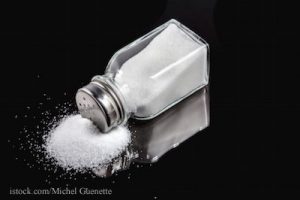The Food and Drug Administration wants to help American consumers reduce their sodium intake. On average, U.S. consumers eat about 3300 mg of sodium every day, a full 1000 mg above the 2010 Dietary Guidelines level of 2300 mg. That much sodium can cause development and escalation of high blood pressure, which is a leading cause of stroke, heart disease, and kidney disease.
 Anyone over the age of 51 should reduce their sodium level to just 1500 mg daily. The CDC has reported that children and adolescents consume this high level of sodium too, which doubles their risk of developing high blood pressure. Dr. Jessica Leighton, senior advisor for science in the FDA’s Office of Food and Veterinary Medicine, said, “There has been a common misconception that sodium intake is just a concern for people with high blood pressure. But it’s a health risk for all people, including children.”
Anyone over the age of 51 should reduce their sodium level to just 1500 mg daily. The CDC has reported that children and adolescents consume this high level of sodium too, which doubles their risk of developing high blood pressure. Dr. Jessica Leighton, senior advisor for science in the FDA’s Office of Food and Veterinary Medicine, said, “There has been a common misconception that sodium intake is just a concern for people with high blood pressure. But it’s a health risk for all people, including children.”
Most of the sodium we consume, about 75%, comes in the form of processed foods. It’s important that you read the nutrition labels on processed food products and choose those with lower sodium content. But if you’ve ever watched a show on the Food Network, you know that chefs add tons of salt to their recipes. Restaurant meals are often heavily salted too. Government officials are reviewing ways to reduce sodium levels in foods.
The sodium content in some foods can be surprising. While most people wouldn’t think of breads and rolls are being packed with sodium, they are number on eon the list of the ten foods that have the most sodium. Also on the list are luncheon meats, pizza, poultry (chickens are injected with a sodium solution), soups, sandwiches, cheese, pasta dishes, meat dishes, and savory snack foods. While many restaurants now post nutrition information, you can ask for it if your favorite burger joint does not. The National Heart Lung and Blood Institute and the FDA have more resources for more information.




